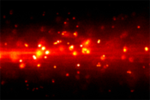Better Image Contrast for Microscopes
Direktzugriff
Artikelaktionen
It is only possible to see an object when it is illuminated: Intelligent illumination thus plays an important role in modern microscopy. It is difficult to properly illuminate samples of up to one millimeter in diameter, because the laser beam used for illumination loses its original form and direction through interaction with the object. For instance, the beam can be diverted from its course by a single barrier or lose its original concentrated form through scattering when it hits multiple tiny particles. In the current issue of the journal Nature Communications, Florian O. Fahrbach and Prof. Dr. Alexander Rohrbach from the Freiburg Department of Microsystems Engineering (IMTEK) and the Cluster of Excellence Centre for Biological Signalling Studies (BIOSS) illustrate how this problem can be avoided, thus improving the quality of microscopic images.
The University of Freiburg research team already demonstrated that special holographically formed self-reconstructing laser beams for microscopes are particularly well suited for this task because they are less susceptible to scattering. These so-called Bessel beams can penetrate deeper into scattering material like embryos or cancer cell clusters. However, scientists long had difficulties figuring out how to use Bessel beams for illumination because the central beam is surrounded by an extensive ring system, which leads to poor image contrast. Fahrbach and Rohrbach have now succeeded in developing a detection method that makes use of the stability of the beam as it spreads through the object. The object is illuminated linearly and simultaneously captured on camera as through a slit diaphragm. This improves image contrast by 50 percent and the axial resolution of the three-dimensional image by nearly 100 percent. The technique is very useful for studying large scattering samples like cell clusters, embryos, skin tissue, small plants, or synthetic materials. The prototype of a microscope using this technology will soon be ready for use at the Faculty of Biology. The research team is currently working on increasing the speed of the camera by over one hundred times.
Fahrbach, F. O., & Rohrbach, A.: Propagation stability of self-reconstructing Bessel beams enables contrast-enhanced imaging in thick media. Nat. Commun.3.632 (2011).
Further information:
http://dx.doi.org/10.1038/ncomms1646
German Press Release
katrin.groetzinger(at)imtek.uni-freiburg.de
Fußzeile
Benutzerspezifische Werkzeuge

